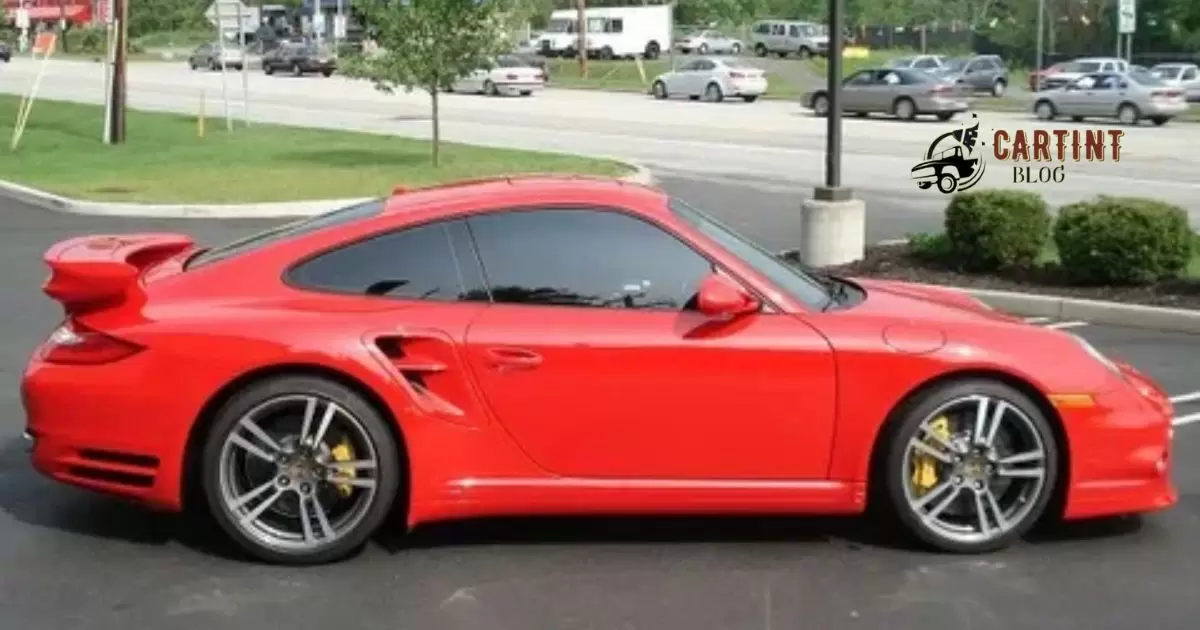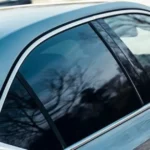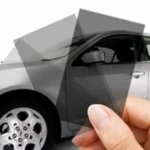The traditional entry-level film applied to automotive glass is tinted window tint. It is essentially an elevated privacy glass, available in a variety of opacities (or darkness). The film consists of an adhesive layer on the bottom, a dyed layer in the middle, and a polyester coating on the surface.
What is Dyed Window Tint for Cars? This cost-effective window tinting method involves the application of a dyed film to car windows. By absorbing sunlight, it not only enhances the vehicle’s aesthetics but also offers protection against harmful UV rays, making it a popular choice among car enthusiasts seeking a balance of style and functionality.
Dyed Window Tint for Cars involves a straightforward process where a dye-infused film is applied to the interior side of the vehicle’s windows. This method is known for its affordability and can effectively reduce glare, heat, and UV rays.
What Are The Benefits Of A Dyed Tints?
Dyed tints for cars offer numerous benefits. Firstly, they effectively reduce glare from the sun, enhancing visibility and reducing eye strain for drivers.
Dyed tints provide substantial UV protection, safeguarding passengers and the vehicle’s interior from harmful sun rays. The dye within the tint absorbs the sunlight, preventing it from entering the car.
Here are some of the main benefits of tinting your car windows.
Offers privacy and security
One of the biggest benefits of window tinting is that it gives you extra privacy in your vehicle. Tinted windows make it difficult for anyone to see inside your vehicle, which is important in keeping your valuables safe.
Reduces the temperature inside the vehicle
Another reason to consider tinting your windows is to keep your car cool during the summer months. Tinted windows can often reduce the heat in your car by up to 60 percent, which is a great way to stay more comfortable while driving on the road.
Protect from UV rays
Automotive window tint also plays a key role in protecting your skin from UV rays. Tinted windows are especially helpful if you’re driving on a long road trip. Tint can help protect against skin cancer while also reducing wrinkles caused by sun damage.
Is Dyed Tints Worth The Money?
Dyed tints for cars are generally not considered worth the money. While they may offer a lower upfront cost, dyed tints tend to fade over time, losing their effectiveness in blocking sunlight and heat. Additionally, these tints often lack the durability and UV protection provided by higher-quality options like ceramic or metalized films.
A tinted tint is only good for privacy and has very little heat rejection. You definitely don’t want a metallic complexion. It’s cheap and interferes with cellular, GPS, and radio signals. If you’re getting color more for heat-rejecting properties than privacy, go with ceramic.
Is Dyed Tints Legal?
In the United States, the legality of dyed tints for cars varies by state. Regulations are set at the state level, with some allowing certain tint percentages while others restrict or ban dyed tints altogether.
For instance, California prohibits the use of dyed tint on front side windows but allows it on rear windows as long as it meets specific darkness standards. It’s crucial for car owners to check and adhere to their state’s tinting regulations to avoid legal consequences.
The specifics, such as allowable tint percentages and permitted windows, can be obtained from state motor vehicle departments or official resources. Always ensure compliance with local laws to enjoy the benefits of tinting without running afoul of regulations.
Is Dyed Tints Better Than Regular Tint?
Dyed tints for cars offer distinct advantages over regular tint. Dyed tints use a colored film that absorbs sunlight, reducing heat and glare. In contrast, regular tints employ metalized particles, providing less efficient heat reduction.
Dyed tints excel in maintaining interior comfort while preserving visibility, making them a popular choice among car owners.
In terms of cost, dyed tints are generally more affordable than regular tints that may include Hybrid tints. Dyed tints do not interfere with electronic signals, such as GPS or mobile devices, unlike some metalized options.
Here’s a detailed table summarizing the comparison between dyed tints and regular tints.
| Aspect | Dyed Tints | Regular Tints |
| Heat and Glare Reduction | Use a colored film to absorb sunlight efficiently | Rely on metalized particles, providing less effective heat reduction |
| Visibility and Comfort | Excel in maintaining visibility | May compromise visibility compared to dyed tints |
| Cost | Generally more affordable | Tend to be more expensive than dyed tints |
| Electronic Signal Impact | Do not interfere with signals | May impact signals, such as GPS or mobile devices |
This table provides a comprehensive overview of the key differences between dyed tints and regular tints, helping users make an informed decision based on their preferences and priorities.
Which Tint Is Better Dyed Or Ceramic?
Dyed tint is a popular choice for car windows due to its affordability. It contains dye particles that absorb sunlight and reduce glare, providing privacy to occupants. However, dyed tint tends to fade over time and may not offer as much heat rejection as ceramic tint.
On the other hand Ceramic tint comes out on top when it comes to UV protection and heat rejection. Its advanced construction helps block nearly 99% of harmful UV rays and rejects significant amounts of solar heat, keeping your ride cool and protecting your car’s interior from sun damage.
Below is a detailed table comparing dyed tint and ceramic tint for car windows.
| Feature | Dyed Tint | Ceramic Tint |
| Cost | Affordable | More expensive than dyed tint |
| Heat Rejection | Moderate | Superior |
| Glare Reduction | Effective | Effective |
| Privacy | Provides privacy | Provides privacy |
| Fading Over Time | Prone to fading over time | Does not fade, offers long-lasting color stability |
| Infrared Radiation Block | Less effective in blocking infrared radiation | Highly effective in blocking infrared radiation |
| Durability | Moderate | Highly durable, does not degrade over time |
| Longevity | May need replacement due to fading | Long-lasting, requires minimal maintenance |
| Professional Installation | Commonly installed by professionals | Requires professional installation |
| Overall Recommendation | Cost-effective, suitable for budget-conscious | Premium option, offers superior performance and durability |
This table provides a detailed breakdown of the key features and characteristics of dyed tint and ceramic tint, helping you make an informed decision based on your priorities and preferences.
How Long Does Dyed Tints Last?
Standard window tint usually lasts an average of 5 years. However, high-quality films made from metal, ceramic and high-grade polyester can last up to 10 years. Always remember that the lifespan of window tint will inevitably decrease over time if maintenance is not done properly
For optimal longevity, it’s necessary to follow proper care and maintenance guidelines. Regularly cleaning the tinted windows with a mild, non ammonia based cleaner and avoiding abrasive materials can contribute to extending the lifespan of dyed tints.
Budget-Friendly Dyed Tints
Explore budget-friendly dyed tints for cars to enhance your vehicle’s aesthetic appeal. These tints provide a cost-effective solution for adding style and privacy to your car windows. With prices starting at $50, you can achieve a sleek and customized look without breaking the bank.
When focused on practicality, these dyed tints offer more than just visual enhancements. They block up to 99% of harmful UV rays, providing added protection for you and your passengers. Installation is quick and efficient, ensuring a professional finish. Upgrade your car’s appearance and functionality with these affordable and efficient dyed tints.
How Is Dyed Window Tint Made?
Dyed window tint for cars is made by infusing a layer of dye into the film during the manufacturing process. This dye absorbs and dissipates solar energy, reducing heat and glare inside the vehicle. The dye is typically added to the adhesive layer, providing efficient heat rejection without affecting visibility.
Step By Step Process
1. Material Preparation
Begin by gathering the necessary materials, including a clear window film and a tinting dye solution. Ensure the workspace is clean and well-ventilated.
2. Film Cutting
Measure and cut the clear window film according to the dimensions of the car windows. Use precision tools to achieve accurate cuts, ensuring a proper fit.
3. Dye Application
Lay the cut film on a flat surface and apply the tinting dye evenly across its surface. Use a specialized tool like a squeegee to ensure uniform distribution and remove any air bubbles.
4. Drying Process
Allow the dyed window film to dry completely. This step is crucial for the dye to bond with the film effectively and ensure long-lasting performance.
5. Adhesive Application
Apply a layer of adhesive to the dyed side of the film. Ensure the adhesive is spread evenly to facilitate a strong bond between the film and the car window.
6. Installation
Carefully place the dyed and adhesive-coated side of the film onto the interior of the car window. Smooth out any air bubbles using the squeegee and ensure a secure, bubble-free fit.
7. Final Trimming
Trim any excess film around the edges of the window for a neat and professional appearance. Pay attention to detail to achieve a polished and finished look.
8. Quality Check
Inspect the installed dyed window tint for any imperfections or bubbles. Make necessary adjustments to ensure the tint adheres well to the glass surface.
9. Cure Time
Allow the tint to cure for the recommended time before exposing it to external elements. This step is crucial for the tint to fully set and provide optimal heat and UV protection.
10. Cleaning and Maintenance
Instruct the vehicle owner on proper cleaning and maintenance procedures to prolong the life of the dyed window tint. Advise against using abrasive cleaners that may damage the tinted surface.
Can You Have Colored Window Tint?
Tinted window tints are an affordable way to get a custom look. The tinted window tint is made with integrated, color-stable dyes to retain the deep charcoal hue. Other tints only apply color to the surface, making them less durable and likely to be pigmented.
Choose your favorite shade that also comes with heat rejection and added privacy. The deeper you go, the more heat rejection and privacy you get
Does Dyed Window Tint Help Reduce Heat?
The short answer is yes, window tint reduces thermal radiation and therefore heat. In fact, this is one of the biggest reasons to tint the windows in your car, home or office.
Dyed window tint, commonly used in car applications, does help reduce heat. These tints contain a dye that absorbs and reflects sunlight, preventing a significant amount of heat from entering the vehicle.
In practical terms, dyed window tint can reduce interior temperatures by up to 10-15 degrees Fahrenheit, providing a more comfortable driving experience.
How Does Dyed Window Tint Compare To Ceramic Tint?
The biggest difference between these two types of window tint is what they are made of. While tinted film consists of polyethylene, dye and other types of UV blockers, ceramic window tint is made from layers of titanium nitride and microscopic particles of film.
What does this mean for your car?
Well, ceramic window tint is much stronger than other types of film. It performs better than almost any other option on the market, which can benefit your vehicle in many ways.
Is There A Better Alternative To Dyed Window Tint?
Carbon window tints are made of carbon fiber particles that do not fade over time. They are more effective at blocking the sun’s rays than tinted or metallic shades. Ceramic tinting has a matte finish, which many people prefer for aesthetic reasons.
Carbon tinting also has very strong insulating properties. It reduces the heat from the sun which increases the interior temperature of the vehicle by about 40%.
One of the downside to carbon tinting is that it can be much more expensive than other products. But its durability and longevity may make up for the expected extra money you’ll pay.
FAQs
What is the difference between dyed and metalized tint?
Dyed tint relies on dye to absorb sunlight, while metalized tint uses metallic particles to reflect and block heat.
Does dyed tint block heat?
Yes, dyed tint provides basic heat reduction by absorbing sunlight, but it may not be as effective as other types.
Types of window tint for cars?
There are various types, including dyed, metalized, ceramic, and carbon window tints, each with unique features and benefits.
Dyed window tint vs carbon?
While dyed tint absorbs sunlight using dye, carbon tint utilizes carbon particles for enhanced heat rejection and durability.
What type of window tint is best?
The best window tint depends on preferences and priorities; ceramic tint is often preferred for superior heat rejection and longevity.
Conclusion
Dyed window tint for cars offers a budget-friendly option for those seeking basic heat and UV protection. With its reliance on a layer of dye to absorb sunlight, dyed tint can help reduce glare and keep the interior cooler. However, it’s essential to note that over time, dyed tint may experience fading, which could impact its effectiveness.
When considering dyed tint, weigh the cost-effectiveness against potential fading and evaluate whether it meets your specific needs for sun protection. While it may be an economical choice, other tint options, such as ceramic or carbon, provide enhanced performance and durability, offering a broader range of benefits for long-term satisfaction.
Meta Description
Discover the benefits of dyed tint for cars – cost-effective UV protection & glare reduction. Learn more about dyed window tint today.



